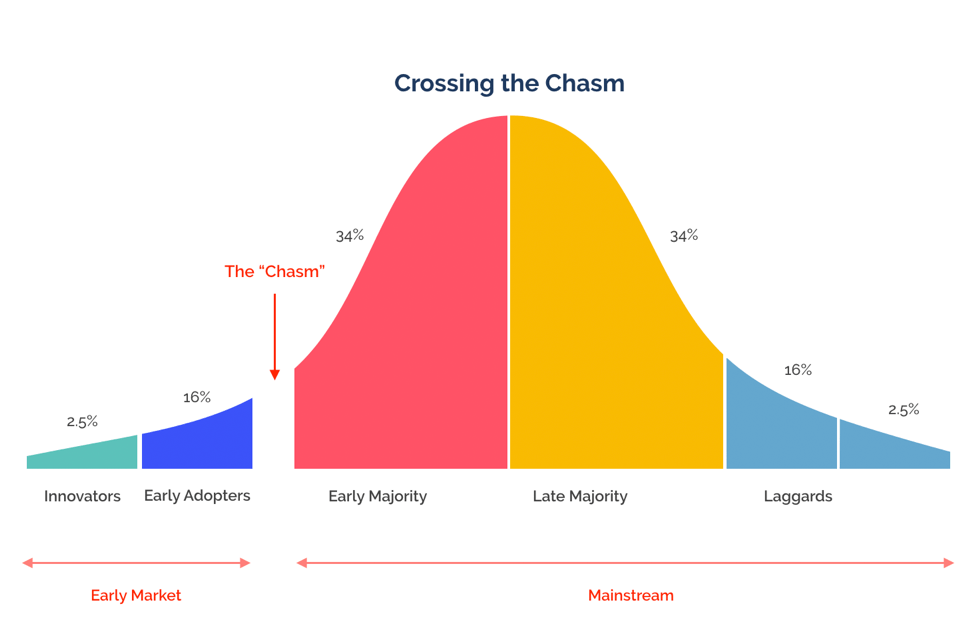Home > Insights > Sales & Marketing > Important Frameworks Needed to Plan a Commercial Strategy
Important Frameworks Needed to Plan a Commercial Strategy
By: Kiran Chin
May, 2020

There are many factors to take into consideration when thinking about a commercial strategy. We believe that the Growth Curve and the “Crossing the Chasm” are two of the most fundamental concepts to consider in the volume of information available when it comes to frameworks, strategies, matrices, etc.
Commercialization frameworks abound. There are several topics, many books written on this, and many a business school program seeking to teach students on how to approach business.
However, there are a few topics that we feel are core to helping organizations ground their commercialization strategies. These two include the growth curve and the “diffusion process” or “adoption curve”.
These two concepts discuss where a company sits on the growth curve for its products or technology and the adoption curve provides a perspective of its success relative to its customers. Therefore the when taken together, these two concepts should provide an inward and outward looking perspective for businesses as they start to build a commercial strategy.
The Growth Curve
The growth curve is widely used to describe the maturity levels of industries, companies, technologies and products.
In this context, a company starts off at the bottom left of the curve and as it starts to grow, moves from “nascent” towards an “emerging” firm with some significant potential for growth. As the company in the “emerging” phase starts to gain traction, that company starts to ramp up the growth curve. In this new state, the company is now considered to be a “growing” company exhibiting high double-digit growth rates. As the company continues up the growth curve, it reaches an inflection point at which its sales start to taper off until slowly it reaches a level of maturity.
At this point, a company has two options in front of it. If it does nothing to address its waning sales, it will continue to decline. However, if it is proactive in responding to the changing needs of its customers or the industry, it could transform itself and enter a new cycle of growth.

Crossing the Chasm
The “crossing the chasm” concept provides a different perspective to the growth curve by providing insights into the customer adoption process of a new or innovative technology, based on consumer buying behaviors.
This “chasm” is a precipitous drop-off that occurs when a company fails to capitalize on the early wins that have created momentum that would allow it to ramp up the growth curve. It often happens because the appetite for risk and new technology combined with the purchasing behavior of the large majority differs from that of the early adopters. Early adopters value access to newest technologies over and above tested/proven technology. Whereas the majority want to see and hear performance results prior to making purchasing decisions – they are slightly less risk averse but will adopt if they see testimonials or positive reviews from others.
Note, there are smaller chasms that exist between each of the customer categories and different challenges exist to bridge the gap. However, the most notable one worth mentioning is the big “chasm” from early adopters to early majority.

The Commercial Framework
- Product/Technology Roadmap & Pipeline
What are the current products ready for commercialization, what can be modified with little development effort, what requires significant development effort but could generate significant returns? Is there focus & direction? Can you be led by customers enough to know which direction to pick would be of significant value rather than responding to every change in customer input/feedback? - Pricing Strategy
What is the cost to develop the products/technology including fixed and variable costs? Depending on where you are in the adoption of your technology/products, would you be able to offer at-cost or low-cost pricing to drive adoption before changing the pricing strategy given the increase in demand? - Promotion & Differentiation
What efforts are you engaged in for driving market awareness? What is the content generation strategy? Why should customers care? With so much noise in the industry – how do you differentiate yourself relative to competitors? - Fundraising
If you are fundraising, do you have an investor deck? Have you told the customer challenge that you are trying to solve for succinctly? How do investors know about you? Why should they care? Have you used this buy-in to promote to customers? - Sales
What is the universe of customers and how do you segment them into manageable target categories? Have you identified the opportunities for high dollar sales? Are there alternative strategies such as distributors, OEMs or other partnerships that may accelerate your firm’s growth? - Structure is strategy
What resources and divide and conquer strategy is in place to ensure diffusion of effort? - Competitive Awareness
Are you aware of your firm’s perceptions relative to your peers when it comes to performance, customer service, technological superiority? What are pricing comps? Are competitors acquiring/consolidating? Launching new products? Aggressively investing in sales, marketing or R&D? how do you remain competitive amidst the shifting competitive landscape? Has a competitor outpaced your development efforts and beat you to market? How should you respond? - Perspective
Is the ability to succeed grounded in reality? Is perspective diluted because leaders and employees are too close to the product/technology? - Decision-Making Ability
Can you make rapid decisions? Do you have the ability to make decisions?
Insight
Bottomline, these two concepts combined with these handful of questions are only but a few of the considerations for running a business. Business is about strategy, insights, knowledge and the ability to compete. We suggest a read of the “Business is a Journey” article that explains the many number of variables that exist when attempting to move from Point A to Point B in a business environment.


